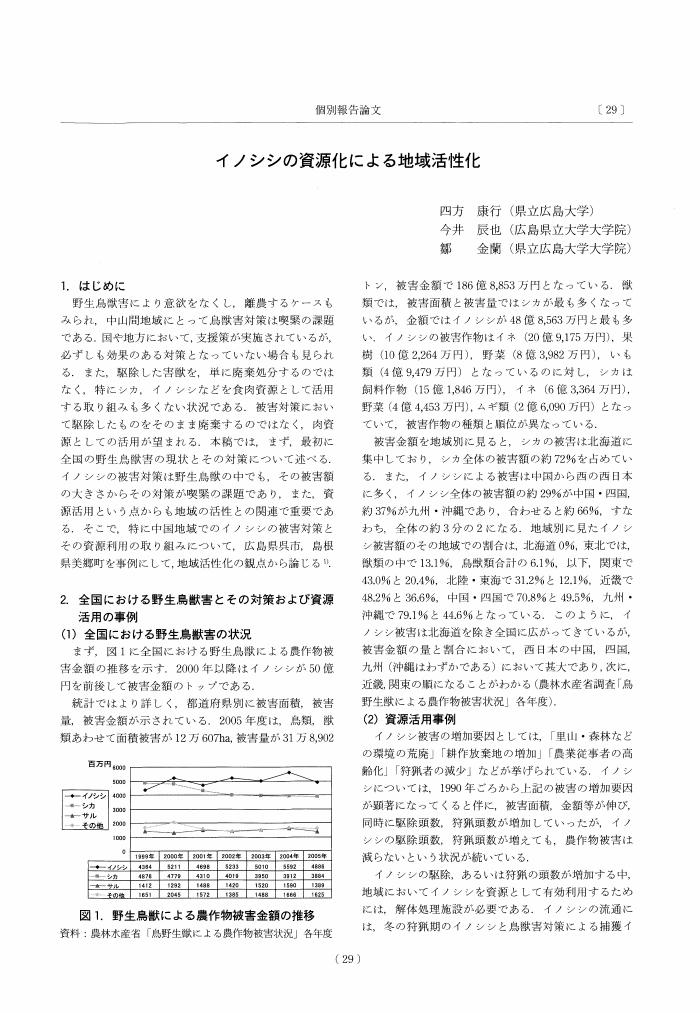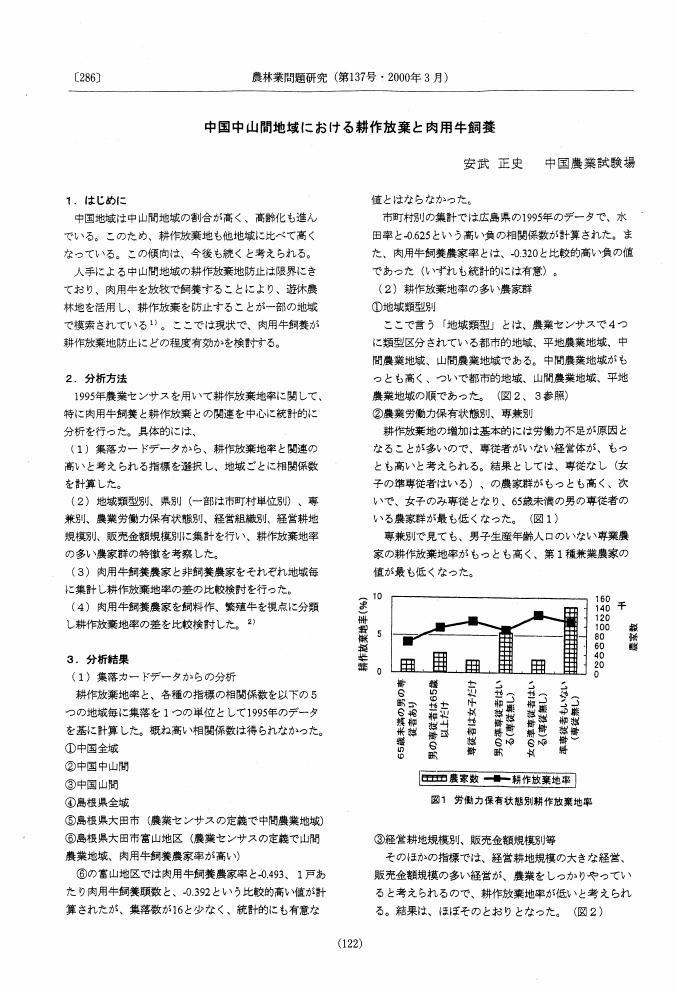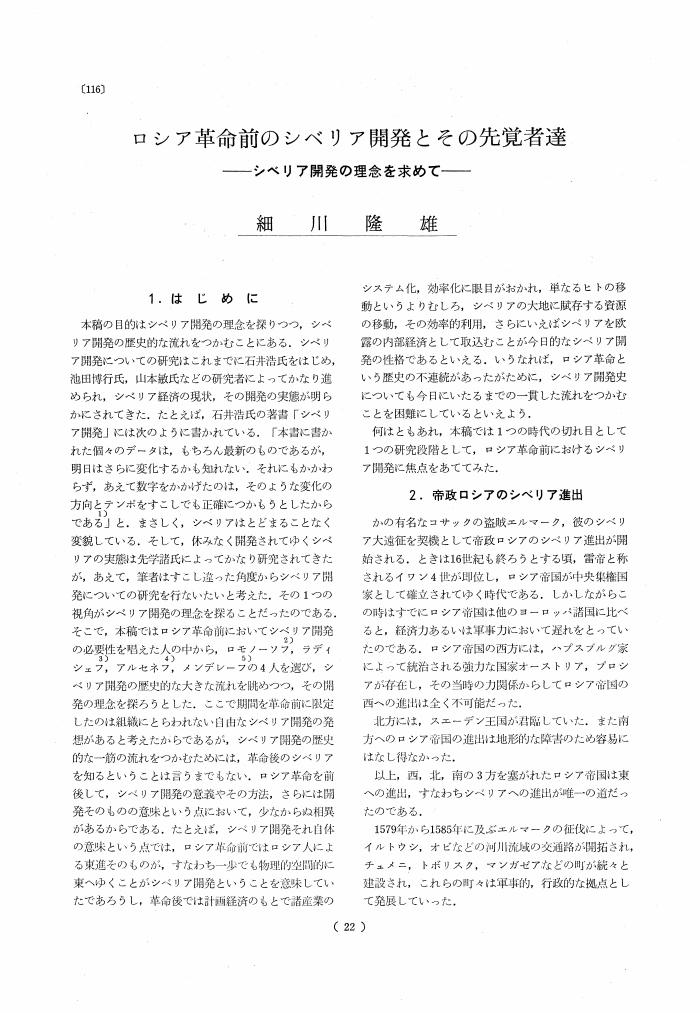- 著者
- 辻村 英之
- 出版者
- 地域農林経済学会
- 雑誌
- 農林業問題研究 (ISSN:03888525)
- 巻号頁・発行日
- vol.39, no.3, pp.241-251, 2003
- 被引用文献数
- 1
Based on the recognition that the current dominant trade never alleviates the poverty of small producers in developing countries, fair trade (FT) which intends to support producers has been developed.Though some recent studies have gone into a discussion of methods to evaluate FT by the absolute criteria of 'fairness', this study attempts to relatively evaluate whether or not FT can improve 'unfairness' of the current dominant trade, which will be clarified by this paper.As far as primary commodities are concerned, theoretical studies on the 'unfairness' of the trade date from the theory of the North-South problem in the 1960s. This paper is written with the aim of advancing a framework for analysis of unfair trade of primary commodities produced in developing countries by adoption of various theories such as the North-South problem, the World-System, the Food-System and the pricing mechanism for agricultural products. What is more, a part of results of the case study (Tanzanian coffee) from within the framework and an evaluation example of FT will be shown.
2 0 0 0 OA 真に必要な地方創生支援とは何か ―西粟倉村での仕事づくりの経験から―
- 著者
- 牧 大介
- 出版者
- 地域農林経済学会
- 雑誌
- 農林業問題研究 (ISSN:03888525)
- 巻号頁・発行日
- vol.52, no.1, pp.10-16, 2016-03-25 (Released:2016-04-01)
2 0 0 0 イギリスにおける外国人季節農業雇用の制度変化と課題
- 著者
- 内山 智裕
- 出版者
- 富民協会
- 雑誌
- 農林業問題研究 (ISSN:03888525)
- 巻号頁・発行日
- vol.46, no.1, pp.104-109, 2010-06-25
- 参考文献数
- 5
- 被引用文献数
- 1
農業における労働力不足を解消するために雇用労働力とりわけ外国人労働力に依存する傾向は、今後強まっていくことが予想される。外国人研修生の受け入れは、労働力確保ではなく開発途上国への技術移転を本来の目的とする。しかし、農業分野でも研修生の所定時間外作業や技能実習生への労働関係法規違反などの不正行為認定件数が2007年度に449件報告されるなど、制度の趣旨と実態にはかい離が見られる。これらの問題に対応し、平成21年度の入管法改正では研修生・技能実習生に国内労働関係法令を適用し、労働者としての権利保護を強化している。この改正そのものは、外国人研修・技能実習制度の趣旨を変更するものではないが、我が国全体の少子高齢化の状況に鑑みれば、農業分野における労働力不足を解消するために、外国人労働力に依存する必要性が今後高まることは不可避であり、その制度設計の検討が重要である。そこで本論では、季節性の強い農業分野における外国人労働力の受入制度を我が国が設計するにあたっての合意を導くことを目的として、イギリスにおける非熟練外国人季節農業労働者受入制度(SAWS)の変遷と実態を分析する。
2 0 0 0 OA イノシシの資源化による地域活性化
2 0 0 0 OA 集落における畦畔管理請負の組織づくりと展望
- 著者
- 木原 奈穂子 中塚 雅也
- 出版者
- 地域農林経済学会
- 雑誌
- 農林業問題研究 (ISSN:03888525)
- 巻号頁・発行日
- vol.56, no.2, pp.70-75, 2020-06-25 (Released:2020-06-30)
- 参考文献数
- 5
The continuity and efficiency of work management of the ridgeways between rice fields have become major issues in Japan. Labor for managing the ridgeways is in short supply, making it necessary to simplify processes, and improve efficiency. Additionally, ridgeways are essential for preserving rural areas and maintaining the landscape; the labor shortage creates problems of maintenance of the area. This study investigated the process of establishing organizations to undertake the management of ridgeways in villages. Consequently, the following three key aspects were identified: 1) Smooth communication between stakeholders, 2) setting of acceptable costs, and 3) improvement of the operation through gradual structuring. Additionally, we found that it was possible to acquire new stakeholders such as non-farmers in the village, thereby making it possible to employ people for maintaining the ridgeways by creating an organization.
2 0 0 0 OA 農業高校の今日的存在意義に関する一考察
- 著者
- 佐々木 正剛 小松 泰信 横溝 功
- 出版者
- 地域農林経済学会
- 雑誌
- 農林業問題研究 (ISSN:03888525)
- 巻号頁・発行日
- vol.37, no.2, pp.84-93, 2001-09-25 (Released:2011-09-05)
- 被引用文献数
- 1 2
Recently, the meaning of the food-agriculture education has been pointed out drawing attention to the education power which agriculture has. An agricultural high school is an educational institution concerned with agriculture. However, its environment is severe. An agricultural high school is the best base facility for food-agriculture education.The followings were pointed out.Firstly, an agricultural high school provides a place for experience study. Secondly, it provides the region with an agricultural technology center and a life study center. Thirdly, it provides a broad network between agricultural high schools. Fourthly, as students are used as assistants, it provides a chance for them to develop their own education skills.
2 0 0 0 OA ヘドニック法による農地の外部経済効果の計測
- 著者
- 多田 稔
- 出版者
- 地域農林経済学会
- 雑誌
- 農林業問題研究 (ISSN:03888525)
- 巻号頁・発行日
- vol.29, no.Supplement2, pp.27-32, 1993 (Released:2011-09-05)
- 参考文献数
- 5
2 0 0 0 OA 中国中山間地域における耕作放棄と肉用牛飼養
- 著者
- 安武 正史
- 出版者
- 地域農林経済学会
- 雑誌
- 農林業問題研究 (ISSN:03888525)
- 巻号頁・発行日
- vol.35, no.4, pp.286-289, 2000-03-25 (Released:2011-09-05)
2 0 0 0 OA 地域社会における小規模水道組合の持続要因に関する研究
- 著者
- 松本 京子 星野 敏 余語 トシヒロ
- 出版者
- 地域農林経済学会
- 雑誌
- 農林業問題研究 (ISSN:03888525)
- 巻号頁・発行日
- vol.49, no.1, pp.82-88, 2013-06-25 (Released:2014-03-14)
- 参考文献数
- 13
This study addresses pertinent factors in sustaining small-scale water supply cooperatives (SWSCs). Based on our survey results, we identified three important areas to be addressed prior to the construction of water-supply infrastructure: (1) Identify the characteristics of communities to be involved in an SWSC, so that the SWSC can understand the shared interests of prospective members, (2) Identify the experiences of local communities in rule-making, for example, those based on neighborhood associations, and (3) For those communities that cannot fulfill (1) and (2), capacity-building among member residents is necessary, if they are to achieve the public or common interests of members through the enactment of SWSCs.
2 0 0 0 OA 農協合併問題の歴史的系譜
- 著者
- 北川 太一
- 出版者
- 地域農林経済学会
- 雑誌
- 農林業問題研究 (ISSN:03888525)
- 巻号頁・発行日
- vol.26, no.2, pp.55-64,103, 1990-06-25 (Released:2011-09-05)
- 被引用文献数
- 1
The main object of this paper is to analyze, being connected with the historical backgrounds and goals of agricultural co-operatives in each period, the historical change of the schemes, which have been mainly proposed by the National Federation of Agricultural Co-operatives (ZENCHU), to promote the amalgamation of agricultural co-opratives.The major results are as follows:(1) The first scheme to promote the amalgamation was established in 1961 by the leadership of the Ministry of Agriculture, Forestry, and Fisheries (NORINSHOU). The Federation was behind in a responce of this issue.(2) It was in the early 1970's when the Federation had decided to promote the amalgamation at the national level. As a result, many amalgamated agricultural co-operatives, which were expanded in the size of organization and that of activity, had emerged.(3) However, in the latter half of the 1970's, the emphasis moved toward standardizing the size of co-operatives. It was considered that the Federation had to modify the basic direction of activity in accordance with economic growth at a slow speed. Then we observed the stagnant tendancy of the amalgamation.(4) Since the latter half of the 1980's, the Federation has been promoting the amalgamation to deal with new circumstances, which surround co-operatives, for example the severe competition in financial market.(5) According to the historical analysis, we can suggest some important issues of the amalgamation of agricultural co-operatives as follows: 1. the amalgamation maintained and strengthened the organization of co-operatives, 2. the amalgamation issue was placed on the well-established position in connection with various functions of cooperatives, and 3. the amalgamating sheme was equipped with the support by administrative office.
2 0 0 0 OA 老農船津伝次平と西洋農学
- 著者
- 内田 和義 中間 由紀子
- 出版者
- The Association for Regional Agricultural and Forestry Economics
- 雑誌
- 農林業問題研究 (ISSN:03888525)
- 巻号頁・発行日
- vol.45, no.1, pp.161-166, 2009 (Released:2012-04-06)
Although Funatsu Denjibei was a trained farmer, he worked at the Komaba Agricultural School, where he managed the farm and lectured students on traditional agricultural techniques. All the other teachers at the Komaba Agricultural School were foreigners and lectured the students on Western Agricultural Science. In this paper, we clarify Funatsu Denjibei’s attitude toward Western Agricultural Science.Funatsu Denjibei contributed to the establishment of modern agricultural science in Japan by imparting empirical knowledge to agriculturists. He kept company with the other foreign teachers and acquired knowledge on Western Agricultural Science from them and the young agriculturists who graduated from the school. Although he used some of this knowledge, it did not influence his agricultural techniques. The agricultural techniques that he advocated had accumulated over years of experience. He attached great importance to them and when the ideas held by other agriculturists ran contrary to his experience, he always retorted and strongly questioned their opinions.
2 0 0 0 OA ロシア革命前のシベリア開発とその先覚者達
- 著者
- 細川 隆雄
- 出版者
- 地域農林経済学会
- 雑誌
- 農林業問題研究 (ISSN:03888525)
- 巻号頁・発行日
- vol.12, no.3, pp.116-123, 1976-09-25 (Released:2011-09-05)
- 参考文献数
- 9
2 0 0 0 二宮尊徳における農業思想の形成
- 著者
- 並松 信久
- 出版者
- 地域農林経済学会
- 雑誌
- 農林業問題研究 (ISSN:03888525)
- 巻号頁・発行日
- vol.19, no.1, pp.28-36, 1983
2 0 0 0 滋賀県における牛肥育の形成過程
- 著者
- 野間 万里子
- 出版者
- 富民協会
- 雑誌
- 農林業問題研究 (ISSN:03888525)
- 巻号頁・発行日
- vol.46, no.1, pp.23-32, 2010-06
文明開化期の牛鍋ブームの中、肉食は、薬食という建前の下許されるものからおおっぴらに楽しむことができるものへと変化した。「肉食はけがれるものとおぼへまして、とんと用ひずにをりましたが、御時世につれまして、此味をおぼへましたら、わすられませぬ」と語られることになる。牛鍋ブームを可能としその後の肉消費拡大を支えたのは、広範に存在した役牛であった。明治初期にはすでに100万頭を超す牛が主に農用として存在しており、耕耘機の普及する1950年ごろまで、一部の乳牛を除き、牛は役肉兼用として飼養されていた。本稿では、明治期から近江牛や江州牛、あるいは神戸牛として高評価の牛を送り出していた滋賀県を事例に、役牛から役肉牛への転換の中でどのように肥育技術が展開し、軟らかい肉を求めるひとびとの食欲に応えようとしたのかを検討する。その際、使役段階と肥育段階とがどのような関係として捉えられていたのかも、明らかにしたい。また、滋賀県における牛肥育が、高級肉消費地である東京との結びつきの中で展開したことも示す。
2 0 0 0 OA 新規定住者を受け入れる農村の意識と立地条件に関する研究
2 0 0 0 OA 属性と経験による地域コミットメントの相違に関する実証分析
1 0 0 0 OA ブーム後のシークヮーサー生産および商品展開のデザイン
- 著者
- 相原 貴之 後藤 一寿 恩田 聡 安田 宗伸 山城 梢
- 出版者
- The Association for Regional Agricultural and Forestry Economics
- 雑誌
- 農林業問題研究 (ISSN:03888525)
- 巻号頁・発行日
- vol.46, no.1, pp.63-68, 2010 (Released:2012-02-24)
- 参考文献数
- 2
- 被引用文献数
- 1
The Siquasa is a small and acid citrus fruit having a distinctive aroma, which is produced in the northern part of Okinawa. The main commercial by-product obtained from this fruit is 100% juice. Recent years have witnessed an increased leveling-off of the sale of Siquasa by-products and lowering of the price of the raw material, i.e., the fruit. It can be said that the production and product development of the Siquasa fruit have entered into a new phase aiming at securing a steady market position. We presented a model design of Siquasa production and product development in the wake of the boom with the aim of facilitating the abovementioned objective. In Okinawa, a form of Siquasa called “Aogiri” is used as vinegar in August and September. Expanding the sale of Aogiri in mainland Japan would create a new demand and market for the product. However, in order to keep obtaining a higher price for Aogiri, it is necessary to ensure a continuous supply of the quality and quantity of the product that the market demands and to build a committed relationship between the areas of production and the market.
1 0 0 0 OA 農薬中毒事故の現状
- 著者
- 奥田 郁夫
- 出版者
- 地域農林経済学会
- 雑誌
- 農林業問題研究 (ISSN:03888525)
- 巻号頁・発行日
- vol.19, no.3, pp.127-134, 1983-09-25 (Released:2011-09-05)
1 0 0 0 OA 中国東北3省における稲作の成長と技術進歩に関する経済分析 単収成長の要因分析を中心に
- 著者
- 張 越傑
- 出版者
- 地域農林経済学会
- 雑誌
- 農林業問題研究 (ISSN:03888525)
- 巻号頁・発行日
- vol.38, no.1, pp.1-12, 2002-06-25 (Released:2011-09-05)
- 参考文献数
- 18
- 被引用文献数
- 2 1
The aim of this paper is to analysis the growth and technological progress of rice production in three northeastern provinces of China, which comprise a major area for the production of Japonica rice, for the period of 1980-1998. Cobb-Douglas production function and other statistical analyses are used for this purpose. The main results are as follows:1) Growth of rice production in the northeastern provinces was contributed to by the spread of cultivating area, and the growth of yield per hectare. In the period analyzed, the former factor was greater than the latter, but was decreasing gradually with time.2) The growth of rice yield per hectare can be explained by the increase of traditional inputs and the technological progress. According to our estimated Cobb-Douglas production function and growth accounting analysis, the contribution of traditional inputs to the growth of yield, such as labor, fertilizer, farm machinery and animal labor, and so on was -18.6%, 30.2%, 21.0% and 8.5% respectively, while the contribution of technological progress, such as HYV and advanced cultivation techniques was 35.4% and 13.4%.3) In the 1990s, HYV adoption reached its peak and then declined, and so did its contribution to the growth of yield. Instead of HYV the adoption of the thinly transplanting technique, which was introduced from Japan, contributed the most (47.3%) among the various forms of input. In the 1980-1998 period, conventional forms of input contributed to the growth of rice yield in those regions by 41.0%, while technological progress contributed by 48.8%.
1 0 0 0 OA 綿作の土地利用方式の変容過程とその農法史上の意義
- 著者
- 荒幡 克己
- 出版者
- 地域農林経済学会
- 雑誌
- 農林業問題研究 (ISSN:03888525)
- 巻号頁・発行日
- vol.32, no.4, pp.173-180, 1997-03-25 (Released:2011-09-05)
Cotton plant had made intensive and scultinized land use pattern with main crops in paddy field in Edo era, but the spreading area of that pattern was not so wide. It was capable only under the condition of fertile paddys with draining well. Cotton plant raised on upland was mostly growed under the successive land use pattern.In Meiji era, most of experienced veteran farmers had realized that crops should principally be raised under the proper rotation. However, cotton plant had been recognized exceptionally to be able, furthermore, to be suitable to raise successively, without any rotation.It is regretable that the precious experience of Japanese farmers to raise cotton plant with intensive and scultinized land use pattern had not been utilized to modernization of Japanese farming system since Meiji era.







